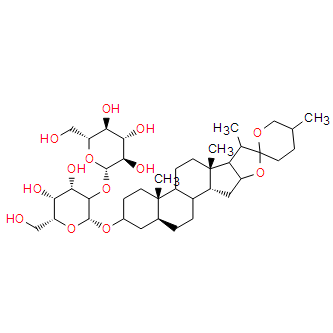| Cas No.: | 41059-79-4 |
| SMILES: | C[C@]1([C@](C2)([H])[C@@](CC[C@@]3([H])[C@]4(C)CC[C@H](O[C@H](O[C@@H]5CO)[C@@H]([C@@H](O)[C@H]5O)O[C@@H]6O[C@H](CO)[C@@H](O)[C@H](O)[C@H]6O)C3)([H])[C@]4([H])CC1)[C@]7([H])[C@@]2([H])O[C@]8(CCC(C)CO8)[C@H]7C |
| Formula: | C39H64O13 |
| M.Wt: | 740.92 |
| Purity: | >98% |
| Sotrage: | 4°C for 1 year, -20°C for more than 2 years |
| Description: | Timosaponin AIII could inhibit acetylcholinesterase (AChE) activity, with an IC50 of 35.4 μM. |
| Target: | IC50: 35.4 μM (AChE)[1]. |
| In Vivo: | Of the tested steroidal saponins, Timosaponin AIII (TA3) most potently improves memory deficits. Timosaponin AIII increases the scopolamine-induced reduction in step-through latency by 17% (10 mg/kg), 28% (20 mg/kg), and 43% (40 mg/kg). During the acquisition trial, no differences in latent time are observed. Timosaponin AIII (20, 40 mg/kg, p.o.) potently inhibits this reduction of acetylcholine in scopolamine-treated mouse brain. The inhibitory effect of Timosaponin AIII is comparable to that of tacrine, which is used as a positive control[1] |
| In Vitro: | Timosaponin AIII could inhibit acetylcholinesterase (AChE) activity, with an IC50 of 35.4 μM[1]. Timosaponin AIII is identified as a major selective cytotoxic activity in BN108, and its selective cytotoxic activity involves inhibition of mTOR, induction of ER stress and protective autophagy[2]. |
| Animal Administration: | Mice[1] Male ICR mice weighing 28-30 g are used. For the acquisition trial, mice are initially placed in the illuminated compartment and the door between the two compartments is opened 10 s later. Each group contains ten mice. One hour or 5 h before the acquisition trial, mice receive each test agent (e.g., Timosaponin AIII 10, 20 or 40 mg/kg, p.o. ). One hour before the acquisition trial, mice receive tacrine (10 mg/kg, p.o.) as a positive control. Memory impairment is induced by scopolamine treatment (1 mg/kg, i.p.) 0.5 h or 4.5 h after the administration of test agents, tacrine, or 10% Tween 80 solution. Control animals are administered 10% Tween 80 solution alone. Twenty-four hours after the acquisition trial, the mice are again placed in the illuminated compartment for retention trials. The time taken for a mouse to enter the dark compartment after the door opened is measured as the latency time in both acquisition and retention trials, with a maximum of 300 s[1]. |
| References: | [1]. Lee B, et al. Timosaponin AIII, a saponin isolated from Anemarrhena asphodeloides, ameliorates learning and memory deficits in mice. Pharmacol Biochem Behav. 2009 Aug;93(2):121-7. [2]. King FW, et al. Timosaponin AIII is preferentially cytotoxic to tumor cells through inhibition of mTOR and induction of ER stress. PLoS One. 2009 Sep 30;4(9):e7283. |

 To enhance service speed and avoid tariff delays, we've opened a US warehouse. All US orders ship directly from our US facility.
To enhance service speed and avoid tariff delays, we've opened a US warehouse. All US orders ship directly from our US facility.




















